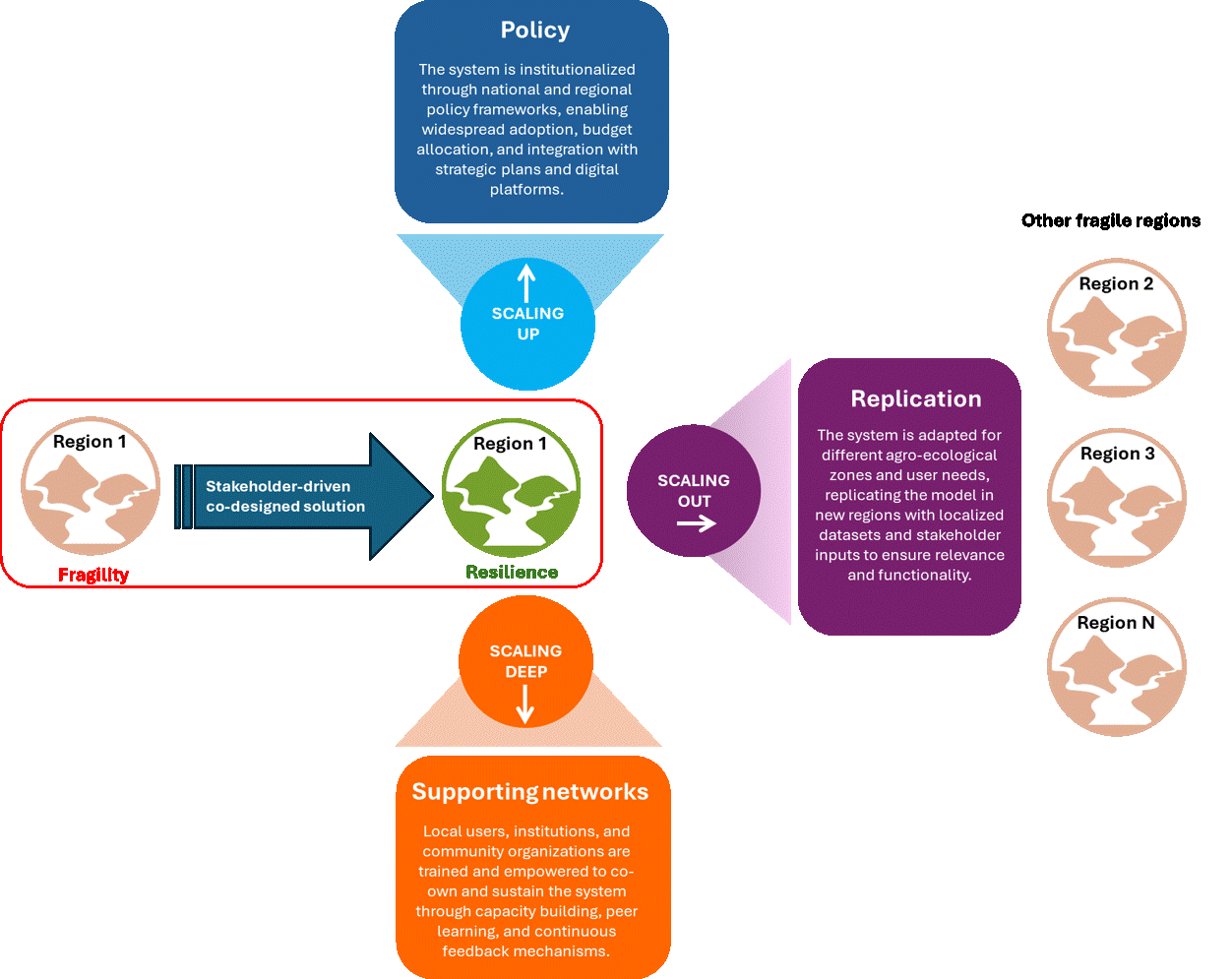Validating, exploring adoption and scaling pathways for NEXAR System: A water intelligence solution for Kashkadarya, Uzbekistan
-
From
Scaling for Impact Program
-
Published on
13.11.25

By Muhammad Khalifa , Maha Al-Zu’bi , Zafar Gafurov , Shavkat Kenjabaev
Water-scarce regions like Kashkadarya in Uzbekistan face increasing pressures from climate change, competing water demands, and fragmented data systems that limit effective decision-making. In response, digital water solutions are emerging to help such regions transition from fragility to resilience.
On 3-4 November 2025, stakeholders from government, research and development sectors convened in Kashkadarya for a two-day workshop dedicated to validate and chart adoption and scaling pathways for the Next-Generation Water Monitoring System for Arid Zones (NEXAR) – a new digital water intelligence tool developed by the International Water Management Institute under and support from the CGIAR Scaling for Impact Program.

Co-designing a next-generation water system
The NEXAR system was initially co-designed in 2024 in close cooperation with Uzbekistan’s Ministry of Water Resources and the Amu-Kashkadarya Basin Irrigation Systems Administration (BISA). In 2025, IWMI developed the NEXAR prototype for piloting in the Kashkadarya Region.
NEXAR aims to overcome the challenges of data scarcity and fragmentation by integrating satellite observations, hydrological measurements and data, and agricultural and energy indicators into a unified digital platform. The system enables users to track seasonal water availability, drought stress, reservoir storage, and water productivity — providing actional insights across the water-energy-food nexus.
 |
 |
From prototype to practice
The workshop emphasized that NEXAR’s long-term impact depends on advancing beyond the prototype phase — ensuring that it can be validated, adopted, and institutionalized within existing governance systems. Opening remarks by IWMI and BISA representatives underscored joint ownership, co-design, and the importance of durable partnership.
A live demonstration of the NEXAR prototype gave participants hands-on experience exploring its modules and interpreting indicators. Through group discussions and anonymous feedback and anonymous survey feedback, participants provided valuable insights into data clarity, user navigation, and integration with local planning workflows.
“This is indeed a new system. We already have a lot of long-term data — for example, on reservoirs, floods, and canal inflows and outflows. We also work on forecasting water availability. However, we currently collect data from separate sources — such as pumping stations, reservoirs, canals, and irrigation water supplied to agriculture — which makes everything fragmented. The NEXAR system brings all this information together on a single platform, making analysis much easier and more coordinated. Once we are fully connected to it, we will be able to plan and implement targeted actions and even define a clear roadmap for the coming years. Having all the necessary data in one place will allow us to make decisions more efficiently.”Akbar Karimov, Head of the Water Resources, Hydrometry, and Dispatch Service Department, Deputy for Water Management, Basin Irrigation System Authority (BISA) “Amu-Kashkadarya” |
“This system is truly essential, and we need to develop it to its full potential. By entering all relevant data, we will be able to access reliable, accurate information that we genuinely need for our work. It will also serve as a valuable knowledge base for new and young specialists, helping them learn and build on the system as they begin their careers.”A’zam Azimov, Chief Hydrometrist, BISA “Amu-Kashkadarya” |
Learning, reflection, and strategy
Day one featured expert presentations on the impacts of climate change on water resources, snow cover, and glaciers in Central Asia, as well as drought typologies and their implications. and their impacts on water resources. Participants also viewed the FCDO documentary “Six Inches of Soil”, which illustrated sustainable land and water management practices relevant to the regional context.
Day two focused on scaling strategy and institutional integration. Through structured sessions and group work, participants identified pathways for transitioning NEXAR from a pilot initiative to an operational system. Discussions explored potential development sites, institutional uptake partners, required capacities, and sustainability mechanisms. There was strong consensus that scaling should follow a phased, pilot-based approach, starting with one canal and gradually expanding to basin and national levels.
“If the system delivers the expected results — starting with one canal as a pilot — we can develop it from the canal to the reservoir and farmers’ fields. This will demonstrate its effectiveness and pave the way for national expansion.”Akbar Karimov, BISA Amu-Kashkadarya |
“This system should be introduced across all regions and tailored to their specific conditions. With adaptation, it will become a national platform enabling effective comparison and analysis between provinces.”A’zam Azimov, Chief Hydrometrist, BISA Amu-Kashkadarya |
Building partnerships for scaling impact
Beyond technical validation, the workshop strengthened collaboration among ministries, basin authorities, research institutes, CGIAR centers, and development partners. This shared understanding of priorities and institutional roles forms a critical foundation for mobilizing resources and mainstreaming digital water governance in Uzbekistan.
The workshop concluded with agreement on the next key steps:
- Refining the NEXAR interface and data flows based on user feedback
- Drafting a joint scaling roadmap
- Developing a training and capacity-building program
- Initiating discussions on multi-partner resource mobilization
Toward a shared platform for resilient water governance
The validation workshop confirmed that NEXAR is ready to move beyond the prototype stage. Partners expressed both strong institutional interest and technical readiness for scaling. The momentum generated positions NEXAR not just as a digital innovation, but as a shared platform for coordinated water governance, partnership-building, and climate resilience — in Uzbekistan and across the wider Central Asian region.
